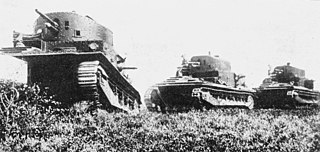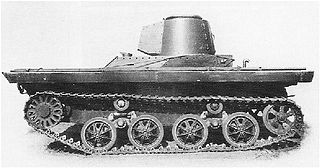
A tankette is a tracked armoured fighting vehicle that resembles a small tank, roughly the size of a car. It is mainly intended for light infantry support and scouting. Colloquially it may also simply mean a small tank.

The TK (TK-3) and TKS were Polish tankettes developed during the 1930s and used in the Second World War.

The Type 94 tankette was a tankette used by the Imperial Japanese Army in the Second Sino-Japanese War, at Nomonhan against the Soviet Union, and in World War II. Although tankettes were often used as ammunition tractors, and general infantry support, they were designed for reconnaissance, and not for direct combat. The lightweight Type 94 proved effective in China as the Chinese National Revolutionary Army had only three tank battalions to oppose them, and those tank battalions were equipped only with some British export models and Italian CV-33 tankettes. As with nearly all tankettes built in the 1920s and 1930s, they had thin armor that could be penetrated by .50 caliber (12.7 mm) machine gun fire at 600 yards (550 m) range.

The Tank, Cruiser, Mk III, also known by its General Staff specification number A13 Mark I, was a British cruiser tank of the Second World War. It was the first British cruiser tank to use the Christie suspension system, which gave higher speeds and better cross-country performance; previous cruiser tank models had used triple wheeled bogie suspension.

Lieutenant-General Sir Giffard Le Quesne Martel was a British Army officer who served in both the First and Second World Wars. Familiarly known as "Q Martel" or just "Q", he was a pioneering British military engineer and tank strategist.

The Light Tank Mark I to Mark V were a series of related designs of light tank produced by Vickers for the British Army during the interwar period.

The T-27 was a tankette produced in the 1930s by the Soviet Union. It was based on the design of the Carden Loyd tankette, bought under license from the United Kingdom in 1930.

The Carden Loyd tankettes were a series of British tankettes of the period between the World Wars, the most successful of which was the Mark VI, the only version built in significant numbers. It became a classic tankette design worldwide, was licence-built by several countries and became the basis of several designs produced in various countries.

Tanks were initially deployed in World War I, engineered to overcome the deadlock of trench warfare. Between the two world wars, tanks were further developed. Although they had demonstrated their battlefield effectiveness, only a few nations had the industrial resources to design and build them. During and after World War I, Britain and France pioneered tank technology, with their models generally serving as a blueprint for other countries. However, this initial advantage would slowly diminish during the 1930s, shifting in favor of the Soviet Union and, to a lesser degree, Nazi Germany.

The T-37A was a Soviet amphibious light tank. The tank is often referred to as the T-37, although that designation was used by a different tank which never left the prototype stage. The T-37A was the first series of mass-produced fully amphibious tanks in the world.

The Type 92 heavy armoured car, also known as the Type 92 cavalry tank, was the Empire of Japan's first indigenous tankette. Designed for use by the cavalry of the Imperial Japanese Army by Ishikawajima Motorcar Manufacturing Company, the Type 92 was designed for scouting and infantry support. The Type 92 was thin armored and lightly armed. Although actually a light tank, it was called sōkōsha in Japanese due to political sectionalism within the Japanese Army. Exactly the same device was used in America with the M1 Combat Car.

Sir John Valentine Carden, 6th Baronet MBE was an English tank and vehicle designer. He was the sixth baronet of Templemore, County Tipperary, from 1931.

The Experimental Mechanized Force (EMF) was a brigade-sized formation of the British Army. It was officially formed on 1 May 1927 to investigate and develop the techniques and equipment required for armoured warfare and was the first armoured formation of its kind in the world. It was renamed the Armoured Force the following year. The Royal Air Force (RAF) took part in the exercises and demonstrated the value of ground–air co-operation.

The Tančík vz. 33 was a Czechoslovak-designed tankette used mainly by Slovakia during World War II. Seventy-four were built. The Germans seized forty when they occupied Bohemia-Moravia in March 1939; there is no record of their use. The Slovak Republic inherited thirty at the same time when it declared independence from Czechoslovakia. In Slovak service it only saw combat during the Slovak National Uprising.

A light tank is a tank variant initially designed for rapid movements in and out of combat, to outmaneuver heavier tanks. It is smaller in size with thinner armor and a less powerful main gun, tailored for better tactical mobility and ease of transport and logistics. They are primarily employed in the screening, armored reconnaissance, skirmishing, artillery observation, and supplementing landing operations in a fire support role of expeditionary forces where larger, heavier tanks are unavailable or have difficulties operating safely or efficiently.

The Vickers-Carden-Loyd light amphibious tank, was a series of British experimental pre-World War II light tanks, which, although not taken into British service, were sold to a number of other countries which produced modified versions which were then taken into service.

PZInż 130 was a prototype of Polish amphibious tank of the 1930s. Only a single prototype was built.
Captain Vivian Graham Loyd MC was an English soldier and engineer who designed armoured vehicles including the Carden Loyd tankette and Loyd Carrier.

The Škoda MU-4 Tankette was a Czechoslovakian tankette design of 1933. It was designed as a successor to the Škoda MU-2 tank.

















